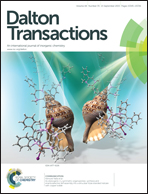Lanthanide mixed-ligand complexes of the [Ln(CAPh)3(Phen)] and [LaxEu1−x(CAPh)3(Phen)] (CAPh = carbacylamidophosphate) type. A comparative study of their spectral properties†
Abstract
A series of complexes Ln(Pip)3(Phen) (Ln(III) = La, Ce–Nd, Sm–Lu, Y; HPip (CAPh type ligand) = 2,2,2-trichloro-N-(dipiperidin-1-yl-phosphoryl)acetamide, Phen = 1,10-phenanthroline) has been synthesized. The lanthanum(III) doped europium(III) complexes ([LaxEu1−x(Pip)3(Phen)], x = 0.99, 0.95, 0.50) have been obtained by the co-crystallization method. The complexes have been characterized by means of X-ray diffraction, IR, 1H and 31P-NMR and absorption spectroscopy. Emission and excitation luminescence spectra were recorded at 295 and 77 K. The lifetime values (τ) for the emission of all europium complexes were determined. The 5D0 luminescence quantum efficiency is 73–89%. The symmetries of the nearest europium surrounding in pure and doped complexes were evaluated from the Stark splitting of 5D0–7FJ transitions. Crystal structures of [Ln(Pip)3(Phen)] (Ln = Nd (1), Eu (2) and Tb (3)) have been determined. Lattice parameters of the [Ln(Pip)3(Phen)] (Ln = Tb, Yb) and the doped [LaxEu1−x(Pip)3(Phen)] (x = 0.99, 0.95, 0.50) complexes have been measured. The presence of four polymorphs within a number of rare earth elements has been estimated: two in triclinic (Ln1 = La, Nd; Ln2 = Eu), one in the monoclinic (Ln3 = Tb) and one in the rhombic (Ln4 = Tb, Yb) symmetry. Complex 3 can be obtained in two crystal modifications: monoclinic and orthorhombic ones.
![Graphical abstract: Lanthanide mixed-ligand complexes of the [Ln(CAPh)3(Phen)] and [LaxEu1−x(CAPh)3(Phen)] (CAPh = carbacylamidophosphate) type. A comparative study of their spectral properties](/en/Image/Get?imageInfo.ImageType=GA&imageInfo.ImageIdentifier.ManuscriptID=C5DT02557E&imageInfo.ImageIdentifier.Year=2015)

 Please wait while we load your content...
Please wait while we load your content...